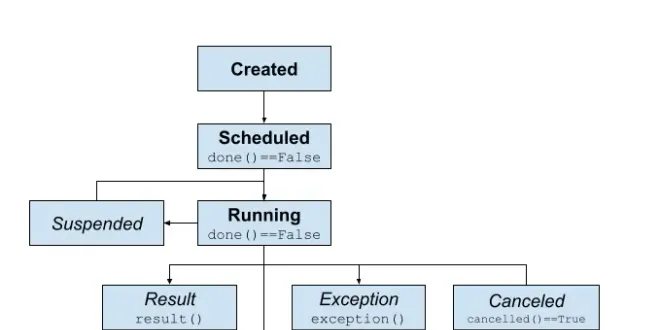Asyncio Task&Futures

What is an Asyncio Task
You can create Task objects from coroutines in asyncio programs. Tasks provide a handle on independently scheduled and running coroutines and allow the task to be queried, canceled, and results and ex...
📚 Read more at Super Fast Python🔎 Find similar documents

Asyncio Task Life-Cycle
An asyncio task has a 4-part life-cycle that transitions from created, scheduled, running, and done. In this tutorial, you will discover the life-cycle of an asyncio Task in Python. Let’s get started....
📚 Read more at Super Fast Python🔎 Find similar documents

Asyncio Concurrent Tasks
We can execute asyncio tasks and coroutines concurrently, a main benefit of using asyncio. There are four main ways that we can achieve this, including issuing coroutines as independent tasks and awai...
📚 Read more at Super Fast Python🔎 Find similar documents

What is an Asyncio Pending Task
A task that is scheduled or suspended will be assigned an internal state of “pending“. In this tutorial, you will discover pending asyncio tasks in Python. Let’s get started. What is an Asyncio Task A...
📚 Read more at Super Fast Python🔎 Find similar documents

concurrent.futures.Future vs asyncio.Future
The Python standard library provides two Future classes. The first is in the concurrent.futures module and the second is in the asyncio module: This raises the question: What is the difference between...
📚 Read more at Super Fast Python🔎 Find similar documents

How to Create Asyncio Tasks in Python
You can create a task from a coroutine using the asyncio.create_task() function, or via low-level API functions such as asyncio.ensure_future() and loop.create_task(). In this tutorial, you will disco...
📚 Read more at Super Fast Python🔎 Find similar documents

Why Asyncio Task Never Runs and Completes
You can develop an asyncio program that schedules background tasks, but then never gives them an opportunity to run or complete. We can allow background tasks the opportunity to start running after th...
📚 Read more at Super Fast Python🔎 Find similar documents

When Does Asyncio Switch Between Tasks
You may be wondering how asyncio chooses which task to run and how it switches between tasks. This is an important question and highlights how asyncio tasks are different from typical Python functions...
📚 Read more at Super Fast Python🔎 Find similar documents

How to use asyncio.TaskGroup
You can manage a collection of asyncio.Task objects as a group using the asyncio.TaskGroup class. The asyncio.TaskGroup will allow tasks to be created, keep track of issued tasks, cancel all tasks if ...
📚 Read more at Super Fast Python🔎 Find similar documents

Asyncio Cancel Task and Wait
You can develop a helper function to cancel an asyncio task and wait for it to be cancelled. In this tutorial, you will discover how to cancel a task and wait for it to be cancelled. Let’s get started...
📚 Read more at Super Fast Python🔎 Find similar documents

Asyncio Periodic Task
You can run an asyncio task periodically in the background. This requires developing a new periodic() coroutine that runs in a loop forever, each iteration sleeping for a given number of seconds and a...
📚 Read more at Super Fast Python🔎 Find similar documents

Asyncio Task Cancellation Best Practices
Last Updated on December 20, 2023 Tasks in asyncio can be canceled manually and automatically. Therefore, we must develop asyncio programs with the expectation that our custom tasks may be canceled at...
📚 Read more at Super Fast Python🔎 Find similar documents

